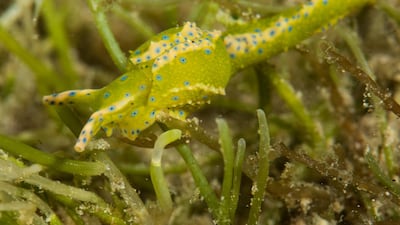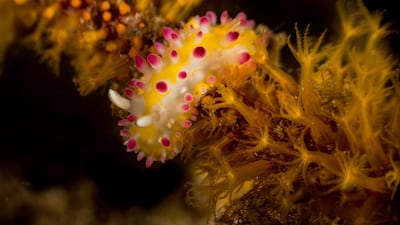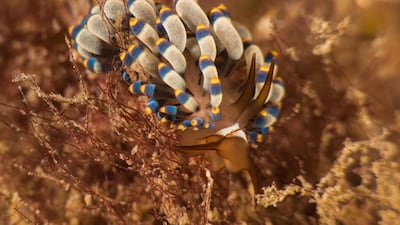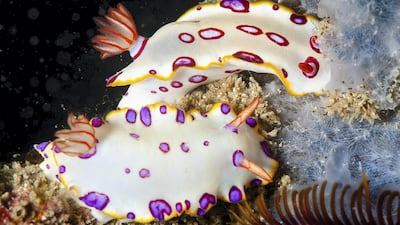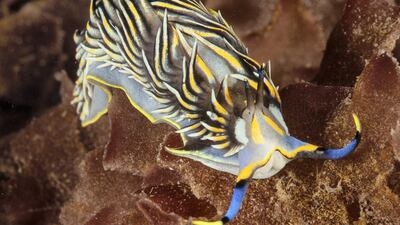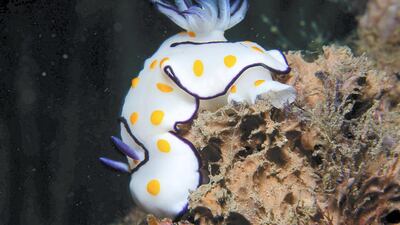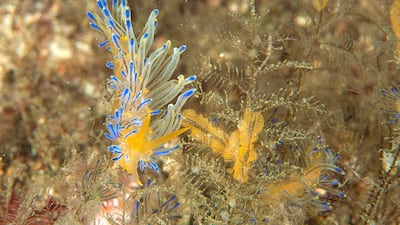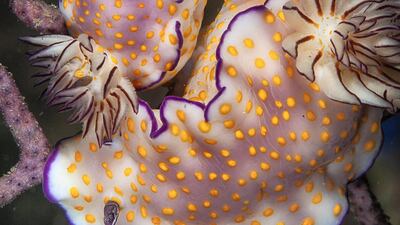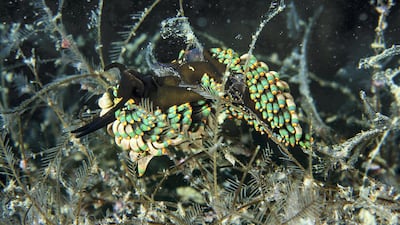At the sight of their misshapen, oblong bodies, flush in bright streaks of nature’s most lurid colours, some might be convinced that these animals are aliens. And in many cases, they are.
The nudibranch is a jelly-like mollusc that lives in oceans around the world, from the Arctic to more temperate seas. Typically, the largest variety of species are found in shallow, warm-water reefs, but some specimens have been found at depths of 2,500 metres, living in waters too deep even for light to penetrate.
The Arabian Gulf and Sea of Oman are home to a surprisingly large number of these nudibranchs, with records of 300 varieties found in the UAE's waters – 10 per cent of the 3,000 species currently known to science.
In the past 10 years alone, nudibranchs that were previously believed to be endemic to the shores of Malaysia and Zanzibar have been documented in the coastal waters of the UAE.
Although scientists are still researching how the slugs made their way to the Emirates, it is believed that the UAE’s shipping ports, among the busiest in the world, could be responsible for this alien invasion.
"They are an invasive species. The first thing you need to know is that nudibranchs travel as pelagic eggs. There is a lot of shipping in the UAE so you see that a lot of nudibranchs travel in ballast waters," said Dragan Petkovic, founder of UAE Branchers – a citizen scientist research group.
The eggs of this hermaphroditic animal could be carried or even attach to shipping containers’ ballast compartments, which are commonly evacuated as they dock or depart from UAE ports. This process could be responsible for the introduction of species from the thousands of kilometres of routes along the UAE’s expansive trade network.
Heiko Seim, a member of the group, has spent much of his time scuba diving with an eye out for what he described as the "butterflies of the sea".
“We have identified stuff only known in Japan – it’s a long way for the nudies [short for nudibranch]. How they came to our waters is a good question. It’s possible that they are part of the ocean worldwide soup plankton,” he said, referring to ocean currents changing from rising sea temperatures.
_______________
Read more:
Hammerhead sharks and cowtail rays: eight endangered species found in UAE waters
UAE biodiversity action plan to save sharks from extinction unveiled
Fujairah wants to build world's largest coral garden
_______________
For Mr Petkovic and his collective of scuba divers, this has been a unique chance to document a wide variety of these animals. But not all have been seen before. The UAE Branchers alone have documented 10 species that had previously not been discovered.
With their diversity, it is not hard to convince people that nudibranchs are shell-less relatives of their terrestrial cousins, the slugs.
Almost as if in a display of flamboyance, these marine molluscs strip themselves from their shells at the larval stage and expose their varicoloured soft bodies to the elements.
Despite their jelly-like outer layer, this animal's defence system is one of nature's most bizarre.
As they slowly graze on a wide range of limited mobility marine life, like sponges and coral, the nudibranchs use two tentacles to identify what is edible. But unlike other animals, the molluscs have an appetite for the oceans most unpalatable and toxic animals.
Over the past decade, scientists have discovered that nudibranchs are capable of absorbing the toxins of their prey and even use it in their own defence system.
A study in 2009 by Marine Biology (who or what is this?), found that nudibranchs feeding on jellyfish actually used the latter’s highly toxic stinging cells in their own defence.
“These are really one of nature’s most amazing animals, they eat, their digestive system has the ability to transform their own body,” Mr Petkovic said.
But much remains unknown about this bizarre oblong-shaped slug, but the goal of UAE Branchers, a team of scuba divers in the UAE, to contribute to a wider effort of research on these colorful critters.
Heiko Seim believes that perhaps it is the chance of discovering an unknown species that makes these animals so special to some scuba divers.
"All the other macro stuff in our water is more or less known, but on the nudies there is still a chance you can find stuff that hasn't been recorded.
These colourful creatures will continue to be a pull for scuba divers interested in the smaller animals of the ocean, especially in a sea that is not necessarily known for its visibility.
But the Arabian Gulf is a young sea, and the visibility is a symptom of water that is full of nutrients creating an environment conducive to nourishing life. And, most importantly, it appears to be conducive to the nudibranch.
At any given time, photos taken by UAE Brancher and posted on theirt Facebook page could end up being of a species new to science.
As long as they keep appearing, these divers will continue to keep an eye out.
“I believe there are still two or three thousands more species to discover,” Mr Petkovic said.
Going grey? A stylist's advice
If you’re going to go grey, a great style, well-cared for hair (in a sleek, classy style, like a bob), and a young spirit and attitude go a long way, says Maria Dowling, founder of the Maria Dowling Salon in Dubai.
It’s easier to go grey from a lighter colour, so you may want to do that first. And this is the time to try a shorter style, she advises. Then a stylist can introduce highlights, start lightening up the roots, and let it fade out. Once it’s entirely grey, a purple shampoo will prevent yellowing.
“Get professional help – there’s no other way to go around it,” she says. “And don’t just let it grow out because that looks really bad. Put effort into it: properly condition, straighten, get regular trims, make sure it’s glossy.”
The specs
Engine: Turbocharged four-cylinder 2.7-litre
Power: 325hp
Torque: 500Nm
Transmission: 10-speed automatic
Price: From Dh189,700
On sale: now
Napoleon
%3Cp%3E%3Cstrong%3EDirector%3C%2Fstrong%3E%3A%20Ridley%20Scott%3Cbr%3E%3Cstrong%3EStars%3C%2Fstrong%3E%3A%20Joaquin%20Phoenix%2C%20Vanessa%20Kirby%2C%20Tahar%20Rahim%3Cbr%3E%3Cstrong%3ERating%3C%2Fstrong%3E%3A%202%2F5%3Cbr%3E%3Cbr%3E%3C%2Fp%3E%0A
Company%20profile
%3Cp%3E%3Cbr%3E%3Cstrong%3EName%3A%3C%2Fstrong%3E%20Khodar%3Cbr%3E%3Cstrong%3EBased%3A%3C%2Fstrong%3E%20Cairo%20and%20Alexandria%2C%20in%20Egypt%3Cbr%3E%3Cstrong%3EFounders%3A%3C%2Fstrong%3E%20Ayman%20Hamza%2C%20Yasser%20Eidrous%20and%20Amr%20El%20Sheikh%3Cbr%3E%3Cstrong%3ESector%3A%3C%2Fstrong%3E%20agriculture%20technology%3Cbr%3E%3Cstrong%3EFunding%3A%3C%2Fstrong%3E%20%24500%2C000%3Cbr%3E%3Cstrong%3EInvestors%3A%3C%2Fstrong%3E%20Saudi%20Arabia%E2%80%99s%20Revival%20Lab%20and%20others%3Cbr%3E%3Cstrong%3EEmployees%3A%3C%2Fstrong%3E%2035%3C%2Fp%3E%0A
MANDOOB
%3Cp%3EDirector%3A%20Ali%20Kalthami%3C%2Fp%3E%0A%3Cp%3EStarring%3A%20Mohammed%20Dokhei%2C%20Sarah%20Taibah%2C%20Hajar%20Alshammari%3C%2Fp%3E%0A%3Cp%3ERating%3A%204%2F5%3C%2Fp%3E%0A%3Cp%3E%3C%2Fp%3E%0A
GCC-UK%20Growth
%3Cp%3EAn%20FTA%20with%20the%20GCC%20would%20be%20very%20significant%20for%20the%20UK.%20%20%20%20%20%20%20%20%20%20%20%20%20%20%20%20%20%20%20%20%20%20%20%20%20%20%20%20%20%20%20%20%20%20%20%20%20%20%20%20%20%20%20%20%20%20%20%20%20%20%20%20%20%20%20%20%20%20%20%20%20%20%20%20%20%20%20%20%20%20%20%20%20%20%20%20%20%20%20My%20Department%20has%20forecast%20that%20it%20could%20generate%20an%20additional%20%C2%A31.6%20billion%20a%20year%20for%20our%20economy.%3Cbr%3EWith%20consumer%20demand%20across%20the%20GCC%20predicted%20to%20increase%20to%20%C2%A3800%20billion%20by%202035%20this%20deal%20could%20act%20as%20a%20launchpad%20from%20which%20our%20firms%20can%20boost%20their%20market%20share.%3C%2Fp%3E%0A
Business Insights
- As per the document, there are six filing options, including choosing to report on a realisation basis and transitional rules for pre-tax period gains or losses.
- SMEs with revenue below Dh3 million per annum can opt for transitional relief until 2026, treating them as having no taxable income.
- Larger entities have specific provisions for asset and liability movements, business restructuring, and handling foreign permanent establishments.
EA Sports FC 26
Publisher: EA Sports
Consoles: PC, PlayStation 4/5, Xbox Series X/S
Rating: 3/5
ENGLAND TEAM
England (15-1)
George Furbank; Jonny May, Manu Tuilagi, Owen Farrell (capt), Elliot Daly; George Ford, Ben Youngs; Tom Curry, Sam Underhill, Courtney Lawes; Charlie Ewels, Maro Itoje; Kyle Sinckler, Jamie George, Joe Marler
Replacements: Luke Cowan-Dickie, Ellis Genge, Will Stuart, George Kruis, Lewis Ludlam, Willi Heinz, Ollie Devoto, Jonathan Joseph
Confirmed%20bouts%20(more%20to%20be%20added)
%3Cp%3ECory%20Sandhagen%20v%20Umar%20Nurmagomedov%0D%3Cbr%3ENick%20Diaz%20v%20Vicente%20Luque%0D%3Cbr%3EMichael%20Chiesa%20v%20Tony%20Ferguson%0D%3Cbr%3EDeiveson%20Figueiredo%20v%20Marlon%20Vera%0D%3Cbr%3EMackenzie%20Dern%20v%20Loopy%20Godinez%0D%3Cbr%3E%3C%2Fp%3E%0A%3Cp%3ETickets%20for%20the%20August%203%20Fight%20Night%2C%20held%20in%20partnership%20with%20the%20Department%20of%20Culture%20and%20Tourism%20Abu%20Dhabi%2C%20went%20on%20sale%20earlier%20this%20month%2C%20through%20www.etihadarena.ae%20and%20www.ticketmaster.ae.%0D%3Cbr%3E%3C%2Fp%3E%0A
WOMAN AND CHILD
Director: Saeed Roustaee
Starring: Parinaz Izadyar, Payman Maadi
Rating: 4/5
SECRET%20INVASION
%3Cp%3E%3Cstrong%3EDirector%3A%3C%2Fstrong%3E%20Ali%20Selim%20%3Cbr%3E%3Cstrong%3EStars%3A%3C%2Fstrong%3E%20Samuel%20L%20Jackson%2C%20Olivia%20Coleman%2C%20Kingsley%20Ben-Adir%2C%20Emilia%20Clarke%20%3Cbr%3E%3Cstrong%3ERating%3A%3C%2Fstrong%3E%203%2F5%26nbsp%3B%3C%2Fp%3E%0A
Labour dispute
The insured employee may still file an ILOE claim even if a labour dispute is ongoing post termination, but the insurer may suspend or reject payment, until the courts resolve the dispute, especially if the reason for termination is contested. The outcome of the labour court proceedings can directly affect eligibility.
- Abdullah Ishnaneh, Partner, BSA Law
The specs
Engine: 4.0-litre V8 twin-turbocharged and three electric motors
Power: Combined output 920hp
Torque: 730Nm at 4,000-7,000rpm
Transmission: 8-speed dual-clutch automatic
Fuel consumption: 11.2L/100km
On sale: Now, deliveries expected later in 2025
Price: expected to start at Dh1,432,000
Our legal columnist
Name: Yousef Al Bahar
Advocate at Al Bahar & Associate Advocates and Legal Consultants, established in 1994
Education: Mr Al Bahar was born in 1979 and graduated in 2008 from the Judicial Institute. He took after his father, who was one of the first Emirati lawyers
Results
5pm: Maiden (PA) Dh80,000 (Turf) 2,200m; Winner: Gurm, Antonio Fresu (jockey), Eric Lemartinel (trainer)
5.30pm: Handicap (PA) Dh80,000 (T) 1,600m; Winner: Al Nafece, Al Muatasm Al Balushi, Mohammed Ramadan
6pm: Wathba Stallions Cup Handicap (PA) Dh70,000 (T) 1,200m; Winner: Ashton Tourettes, Adrie de Vries, Ibrahim Aseel
6.30pm: Arabian Triple Crown – Group 3 (PA) Dh300,000 (T) 2,200m; Winner: Ottoman, Adrie de Vries, Abdallah Al Hammadi
7pm: Liwa Oasis – Group 2 (PA) 300,000 (T) 1,400m; Winner: Hakeemat Muscat, Szczepan Mazur, Ibrahim Al Hadhrami
7.30pm: Handicap (TB) Dh80,000 (T) 1,600m; Winner: Ganbaru, Antonio Fresu, Musabah Al Muhairi
The National Archives, Abu Dhabi
Founded over 50 years ago, the National Archives collects valuable historical material relating to the UAE, and is the oldest and richest archive relating to the Arabian Gulf.
Much of the material can be viewed on line at the Arabian Gulf Digital Archive - https://www.agda.ae/en
TO%20CATCH%20A%20KILLER
%3Cp%3E%3Cstrong%3EDirector%3A%20%3C%2Fstrong%3EDamian%20Szifron%3C%2Fp%3E%0A%3Cp%3E%3Cstrong%3EStars%3A%3C%2Fstrong%3E%20Shailene%20Woodley%2C%20Ben%20Mendelsohn%2C%20Ralph%20Ineson%3C%2Fp%3E%0A%3Cp%3E%3Cstrong%3ERating%3A%3C%2Fstrong%3E%202%2F5%3C%2Fp%3E%0A
The specs: 2019 GMC Yukon Denali
Price, base: Dh306,500
Engine: 6.2-litre V8
Transmission: 10-speed automatic
Power: 420hp @ 5,600rpm
Torque: 621Nm @ 4,100rpm
Fuel economy, combined: 12.9L / 100km
Who's who in Yemen conflict
Houthis: Iran-backed rebels who occupy Sanaa and run unrecognised government
Yemeni government: Exiled government in Aden led by eight-member Presidential Leadership Council
Southern Transitional Council: Faction in Yemeni government that seeks autonomy for the south
Habrish 'rebels': Tribal-backed forces feuding with STC over control of oil in government territory
COMPANY%20PROFILE
%3Cp%3E%3Cstrong%3ECompany%20name%3A%3C%2Fstrong%3E%20Alaan%3Cbr%3E%3Cstrong%3EStarted%3A%3C%2Fstrong%3E%202021%3Cbr%3E%3Cstrong%3EBased%3A%3C%2Fstrong%3E%20Dubai%3Cbr%3E%3Cstrong%3EFounders%3A%3C%2Fstrong%3E%20Parthi%20Duraisamy%20and%20Karun%20Kurien%3Cbr%3E%3Cstrong%3ESector%3A%3C%2Fstrong%3E%20FinTech%3Cbr%3E%3Cstrong%3EInvestment%20stage%3A%3C%2Fstrong%3E%20%247%20million%20raised%20in%20total%20%E2%80%94%20%242.5%20million%20in%20a%20seed%20round%20and%20%244.5%20million%20in%20a%20pre-series%20A%20round%3Cbr%3E%3Cbr%3E%3C%2Fp%3E%0A
Living in...
This article is part of a guide on where to live in the UAE. Our reporters will profile some of the country’s most desirable districts, provide an estimate of rental prices and introduce you to some of the residents who call each area home.
